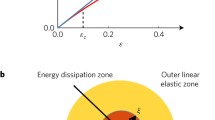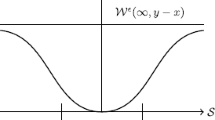Abstract
A renormalization group treatment of a skeletal, hierarchical model of crack fusion and suturing yields the experimental stress versus time-to-fracture law. We construct a model that eliminates the intervening size states in the hierarchy but retains the time delay that represents the time-to-fracture observations. We add a source term to replenish microcracks lost by promotion due to fusion. The system is found to be stable for all values of time delay if the rate of replenishment is steady. If we allow the rate of replenishment of microcracks to be coupled to the rate of appearance of the largest size cracks, which we interpret as large-scale seismicity, then a Hopf bifurcation appears and the system is describable as a limit cycle attractor.
Similar content being viewed by others
References
Allègre, C. J., LeMouel, J. L., andProvost, A. (1982), Nature297, 47–49.
Anderson, O. L., andGrew, P. C. (1977), Rev. Geophys. Space Phys.15, 77–104.
Cherepanov, G. P.,Mechanics of Brittle Fracture (McGraw-Hill, New York, 1979).
Dieterich, J. H. (1979), J. Geophys. Res.84, 2161–2175.
Glathart, J. L., andPreston, F. W. (1946), J. Appl. Phys.17, 189–195.
Griggs, D. T. (1940), Bull. Geol. Soc. Am.51, 1001–1022.
Kagan, Y. Y. (1981a), Geophys. J. R. Astronom. Soc.67, 697–717.
Kagan, Y. Y. (1981b), Geophys. J. R. Astronom. Soc.67, 719–733.
Kagan, Y. Y., andKnopoff, L. (1978), Geophys. J. R. Astronom. Soc.55, 67–86.
Kagan, Y. Y., andKnopoff, L. (1980), Geophys. J. R. Astronom. Soc.62, 303–320.
Means, W. D., andXia, Z. G. (1981), Geology9, 538–543.
Mogi, K. (1962), Bull. Earthquake Res. Inst.40, 107–124.
Newman, W. I. (1983),Nonlinear Diffusion: Self-Similarity and Traveling-Waves, PAGEOPH121, 417–441.
Newman, W. I., andKnopoff, L. (1982), Geophys. Res. Lett.9, 735–738.
Newman, W. I., andKnopoff, L. (1983), Geophys. Res. Lett.10, 305–308.
Newman, W. I., andKnopoff, L. (1984) (in preparation).
Preston, F. W. (1946), Nature156, 55.
Scholz, C. H. (1968), Bull. Seismol. Soc. Am.58, 1117–1130.
Zhurkov, Z. N. (1965), Int. J. Fract. Mech.1, 311–323.
Author information
Authors and Affiliations
Rights and permissions
About this article
Cite this article
Knopoff, L., Newman, W.I. Crack fusion as a model for repetitive seismicity. PAGEOPH 121, 495–510 (1983). https://doi.org/10.1007/BF02590153
Received:
Revised:
Accepted:
Issue Date:
DOI: https://doi.org/10.1007/BF02590153




